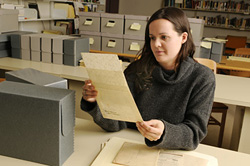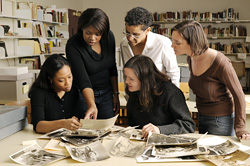About Finding Aids
Introduction to Finding Aids

When faced with organizing a collection of artifacts—be it a bundle of handwritten correspondence, photo albums or scrapbooks, or drafts of poems and novels—archivists devise specific ways to organize and arrange those materials. Was there an original order that the archivist has preserved—if so, how? Should the artifacts/materials be arranged by year, topic, or both? Is it more efficient to file correspondence by the author of a letter or its recipient? Where are things placed relative to one another—are photographs kept together with the collection from which they come, or are they housed in separate files altogether?
Finding aids address these and other questions that researchers are likely to have about a collection's organization. Akin to a map, these guides describe a collection's terrain, identifying what you'll find in a collection (typically in a section titled, “Scope and Contents”); where you'll find it (box and folder numbers listed in a register typically labeled “Series”); and why (also explained in Scope and Contents).
Currently, archivists debate how detailed finding aids should be. One reason why archive collections remain unknown for so long, some contend, is that too much labor is poured into preparing finding aids that account for every single item in a collection. The expense required to support item-level description has slowed collections' processing to a crawl, these critics argue. The debate's other side replies that highly detailed finding aids provide the best access to collections over the long term. In this view, if a collection's contents are individually tallied for researchers' use, chances are that the materials will eventually be studied, since they can't be overlooked (for more on this debate, see Processing Hidden Collections).
MTS seeks to balance these two views. While our field expertise in African American Studies means we can describe collections in great depth, we tend to arrange collections at the folder level; that is, we organize collections by grouping related items together that can be filed in one folder as a particular unit. Thus, rather than create separate folders for each letter exchanged between the poet Robert Hayden and his publisher Heritage Press, we organize one file that contains a specific run of correspondence between Hayden and the press; say, letters dated between 1953 and 1984. We also devise collection-specific tactics to speed our work whenever possible. For instance, while the DuSable Museum's Moving Image Collection Finding Aid notes the films' and videos' titles, the finding aid doesn't provide synopses. To do so would've required months of screening time, thus delaying the preparation of the finding aid.
MTS agrees with archivists that micro-processing collections can block the public's access to valuable research materials. Backlogged or “hidden” collections serve no one's interests. However, as researchers, we value finding aids that tell us more (rather than less) about what a collection holds. Hopefully, the methods MTS devises to produce our finding aids will contribute new models to streamline processing techniques, thus meeting the needs of repositories and researchers alike.
How To Use A Finding Aid

The finding aids prepared by the MTS staff follow a basic format.
First, you'll encounter a section that summarizes background or provenance facts about the collection: when was it acquired by the repository and from where; its overall size; contact information for the repository; citation requirements for the collection; special restrictions on the collection; the author of the finding aid.
Second, you'll find the “Biography” notes. This section sketches the collection subject's history or life. This section closes with two useful pieces of information: a selected bibliography about the collection's subject, and (if relevant) a listing of other repositories where additional holdings of the collection may be housed.
The “Scope and Content” section describes the collection's contents and the methods used to organize it. This section typically points out highlights (or anomalies) in the collection—special artifacts or missing pieces—that researchers may find useful to know. The Scope and Content note also explains the series organization of the collection; that is, how and why certain kinds of materials are grouped together. Finally, the “Container List” enumerates the collection's artifacts by series kind: Correspondence, Manuscripts, Letters, Photographs, Memorabilia, or Miscellaneous. Box by box, folder by folder, the Container List charts the collection's contents within a given series category.
Issues

Please bear two points in mind when using the finding aids prepared by MTS.
At present, the finding aids aren't linked across collections or institutions. That would be accomplished by:
- establishing a common vocabulary with which to describe the collections overall
- devising a cataloguing software system capable of searching across institutions and archival formats to call up relevant items that correspond to the common vocabulary and a researcher's interest
Creating this capability will be the next phase of MTS' work. Thanks to our collaboration with the University of Chicago's Special Collections Research Center and Digital Library Development Center-and with the generous financial support of the Andrew W. Mellon Foundation—MTS's finding aids will be subject and keyword searchable, across institutions and archival formats. This work took place between 2007 and 2010 under the auspices of the UNCAP-Uncovering New Chicago Archives Project—led by the University of Chicago Library.

